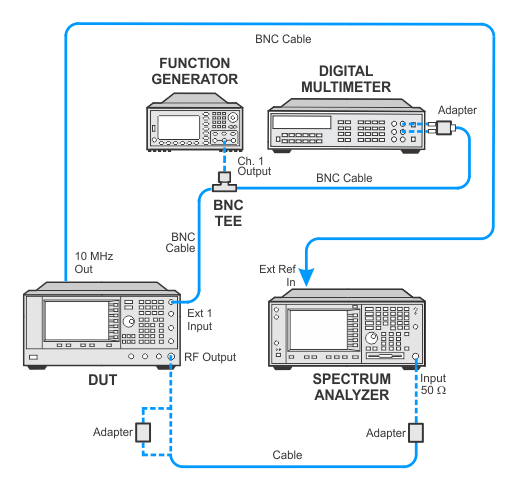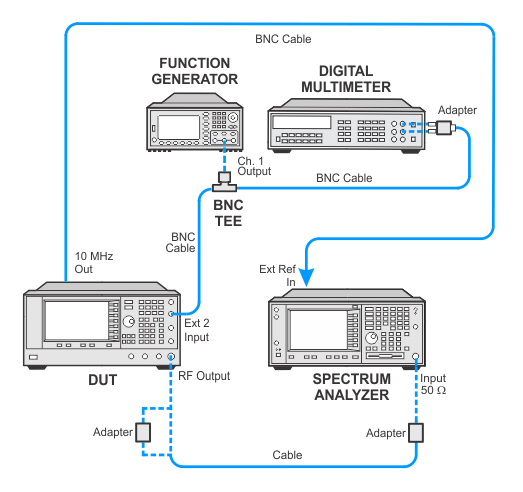![]()
-
All test equipment requires a 30 minute warmup period to ensure accurate performance.
-
In the following test setup, cables are designated as solid lines and direct connections are designated as dashed lines.
External Frequency Modulation Frequency Response verifies that a selected FM deviation remains constant within ± 3 dB as the FM rate is varied from 10 Hz to either 1 MHz or 5 MHz (depending on FM Path) and the DUT CW frequency is varied from 500 MHz to 1.0 GHz while a sinusoidal voltage is being supplied to an external input. If the DUT meets the frequency response specification in this CW frequency range, frequency response in all other frequency ranges will be assured.
For high β conditions (β=fdeviation/frate), the measurement is made by a signal analyzer in zero span by changing the tuned frequency and detecting when the peak input signal drops by 3 dB, indicating that the tuned frequency is beyond the maximum source frequency deviation. For low β conditions, the measurement is made by measuring the adjacent sideband amplitudes and calculating the deviation based on the predicted spectral distribution of a FM signal. All calculations of frequency response in terms of actual/expected frequency deviation are relative to a measurement made at the 1 kHz reference frequency deviation.
|
Test Equipment |
Recommended Models |
Alternative Models |
|
Spectrum Analyzer |
N9030B Opt 5xx1 |
N9030A Opt 5xx1 E444xA2 |
|
Function Generator |
33622A |
33611A |
|
Digital Voltmeter |
3458A Opt 002 |
34470A |
|
|
|
|
Connect all test equipment as shown.
Connect GPIB cables to all GPIB-controlled test equipment.
While performing this performance test, follow all instructions on the controller display.
External Frequency Modulation Frequency Response Test Setup (External 1 Input)

External Frequency Modulation Frequency Response Test Setup (External 2 Input)

If this performance test fails, perform the following steps in order:
Check the equipment setup (see above). If the setup is incorrect, make the necessary corrections and rerun the Performance Test.
If this test fails with the equipment set up properly, refer to the troubleshooting section of the signal generator's service guide. If you do not have a printed copy of the service guide (Option OBW), one is available either on the CD-ROM that came with your signal generator shipment or on the Keysight Website.
If you cannot correct the problem using the troubleshooting procedures in the Service Guide, obtain service from Keysight Technologies. Refer to Contacting Keysight Technologies.
